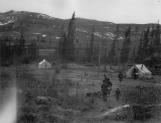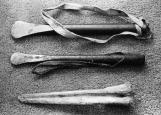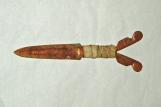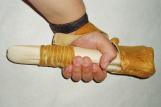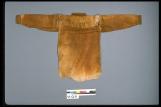1
CONTENTS:- Living on the Land
- Learning Traditional Law: Crow Builds a Fish Trap
- Learning Traditional Law: Girl and the Salmon
- Tools of the Hudé Hudän
- Traditional Clothing
- Traditional Housing
- Transportation: First Dog Team Story
- Trade with the Chilkat Tlingit
2
Living on the LandMany years ago, the Little Salmon Carmacks First Nations people lived a traditional lifestyle and survived from the land. Carmacks is today home to around 350 Northern Tutchone people, whose ancestors come from smaller groups that used to live all around the traditional territory. Elders have described about 11 regional groups from areas like Little Salmon, Big Salmon , Tatchun lake, Taltlmain Lake and the Nordenskiold River area.
Each group's territory was respected by others, and people were responsible for maintaining and safeguarding them. Among these people, the hunting and fishing territory was inherited by a family member of the individual who had died. Northern Tutchone people still practice this tradition today.
The Hudé Hudän travelled around their traditional territory hunting, trapping, fishing and harvesting their food supply. These people used a vast area to meet their needs; many Elders have travlled across the entire LSCFN territory before the time of trucks and four-wheelers!
4
Learning Traditional Law: Crow Builds a Fish TrapElders tell many stories a time that cannot be measured in generations or centuries. During this time animals and birds were different than they are today. They could speak to each other, speak to people, and take on different forms.
From the stories of this time, people learned lessons about Traditional Law, or "Doli". For example, the story 'Crow builds a fish trap' teaches a lesson about proper salmon fishing. In time Crow passed on his knowledge about salmon to the Hudé Hudän.
Long ago, when the world was young, before the Hudé Hudän, Crow decided to build a fish trap on the Yukon River. He tried building a fish trap in one place, but got no fish. Then he tried to build a fish trap a second place at 'Five Finger Rapids' also known as Tthi Cho Nadezhe ("Big rocks standing up").
This time Crow decides to build his trap a different way than the last time. It went right across the river and he got no fish. Therefore, he followed the river down to its mouth at the ocean and there he met 'Salmon Woman'. He married her and brought her back to Tutchone country.
Salmon Woman made salmon appear in the Yukon River with her fingers and toes. This is how salmon had first arrived to the Yukon River. Crow learned from her that it is 'Doli' (against Traditional Law) to build a salmon trap right across a creek or river. You should always leave a channel for them to pass further up.
5
Learning Traditional Law: The Girl and the SalmonThis story occurred during the time of Hudé Hudän (Long Ago People). It teaches a lesson about how to respect salmon The story has been passed down to each new generation so they will understand Traditional Law.
During the time of the Hudé Hudän, a little girl was playing by the river. She was wearing a pretty necklace, at the same time her mother was cutting salmon. The little girl fell in the river. The salmon took her all the way down to their home in the ocean. For one year the salmon kept her and taught her all about the salmon people. The salmon told her how to treat them with respect: don't poke our eyes, don't say "yuck" or anything like that when cleaning salmon.
The mother was cutting salmon at the same place by the river the following summer. She cut open one salmon and she saw the necklace inside and realized it was her lost daughter. With the help of an Indian Doctor, they were able to bring the daughter back to life. She told the Hudé Hudän people all about the salmon people. She also told them the way salmon people wished to be respected by the Hudé Hudän.
7
Tools of the Hudé HudänBefore modern tools made of steel and plastic, people relied on bone, wood, and stone tools to do their work. Scrapers, fleshers, stone axes, sinew snares and bone needles were common tools. There were also larger tools, like wooden fish traps. The tools pictured here were made by today's LSCFN Elders in the way they were taught by their Elders.
11
Traditional ClothingBefore cotton and wool, there was moose and caribou. During the harsh weather, a hide was lined with fur to keep the cold out. The women's garment was a one-piece dress made of moose hide. The men wore a moose hide shirt with a v-shape at the front. The pants and moccasins were sewn into a one-piece combination.
People used colored porcupine quills and dyes made of berries and some plants like Indian Paint (a type of red plant) to decorate their garments. Dentalia shells and copper from the coastal Tlingit traders were also used. Sometimes robes made of ground squirrel or gopher skins were worn. Wealthy people wore marten skin robes or blankets of braided or woven goat hair.
12
LSCFN Elder Agnes Charlie in traditional dress, carrying birchbark baby packerDate not available
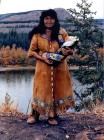 Credits:
Credits:(Courtesy LSCFN)
13
Northern Tutchone moosehide pantsDate not available
 Credits:
Credits:(Courtesy Canadian Museum of Civilization, artifact no. VI Q 8)
